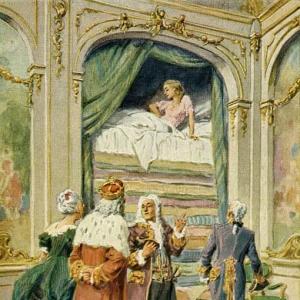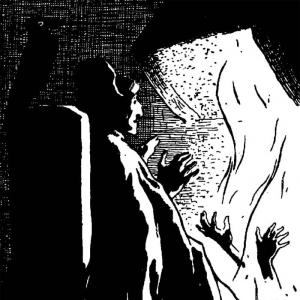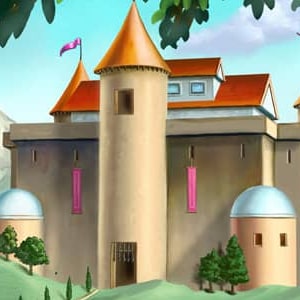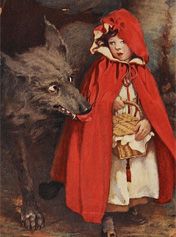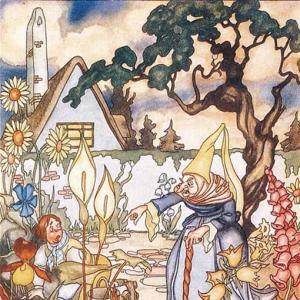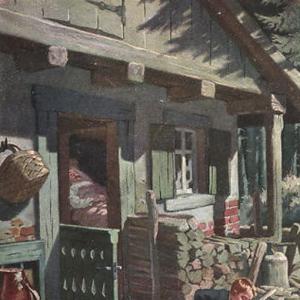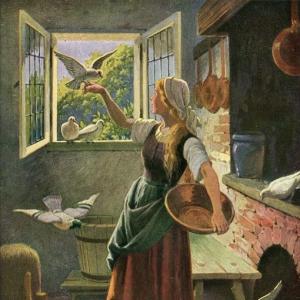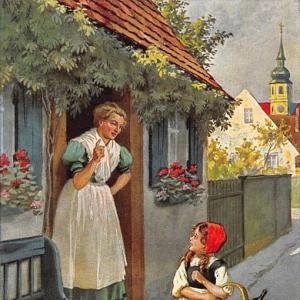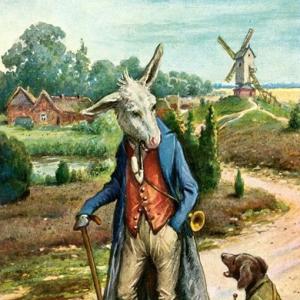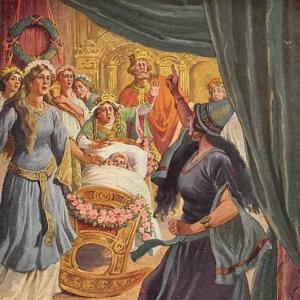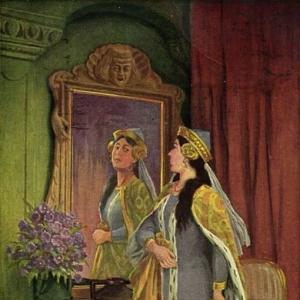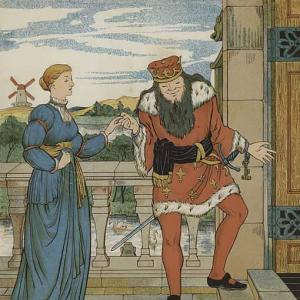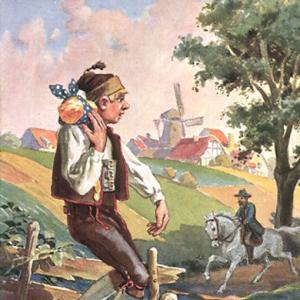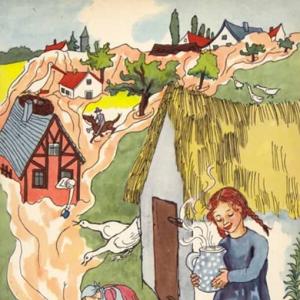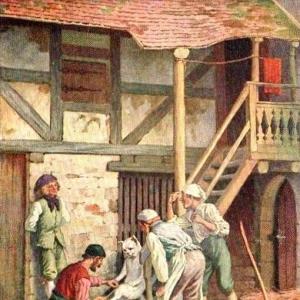Reading time for children: 6 min
There were once a little brother and a little sister, who loved each other with all their hearts. Their own mother was, however, dead, and they had a stepmother, who was not kind to them, and secretly did everything she could to hurt them. It so happened that the two were playing with other children in a meadow before the house, and there was a pond in the meadow which came up to one side of the house. The children ran about it, and caught each other, and played at counting out.
„Eneke Beneke, let me live,
And I to thee my bird will give. The little bird, it straw shall seek,
The straw I’ll give to the cow to eat. The pretty cow shall give me milk,
The milk I’ll to the baker take. The baker he shall bake a cake,
The cake I’ll give unto the cat. The cat shall catch some mice for that,
The mice I’ll hang up in the smoke,
And then you’ll see the snow.“
They stood in a circle while they played this, and the one to whom the word ’snow‘ fell, had to run away and all the others ran after him and caught him. As they were running about so merrily the stepmother watched them from the window, and grew angry. And as she understood arts of witchcraft she bewitched them both, and changed the little brother into a fish, and the little sister into a lamb. Then the fish swam here and there about the pond and was very sad, and the lambkin walked up and down the meadow, and was miserable, and could not eat or touch one blade of grass. Thus passed a long time, and then strangers came as visitors to the castle. The false step-mother thought: „This is a good opportunity,“ and called the cook and said to him: „Go and fetch the lamb from the meadow and kill it, we have nothing else for the visitors.“ Then the cook went away and got the lamb, and took it into the kitchen and tied its feet, and all this it bore patiently. When he had drawn out his knife and was whetting it on the door-step to kill the lamb, he noticed a little fish swimming backwards and forwards in the water, in front of the kitchen-sink and looking up at him. This, however, was the brother, for when the fish saw the cook take the lamb away, it followed them and swam along the pond to the house. Then the lamb cried down to it:
„Ah, brother, in the pond so deep,
How sad is my poor heart! Even now the cook he whets his knife
To take away my tender life.“
The little fish answered:
„Ah, little sister, up on hig
How sad is my poor heart
While in this pond I lie.“
When the cook heard that the lambkin could speak and said such sad words to the fish down below, he was terrified and thought this could be no common lamb, but must be bewitched by the wicked woman in the house. Then said he: „Be easy, I will not kill thee,“ and took another sheep and made it ready for the guests, and conveyed the lambkin to a good peasant woman, to whom he related all that he had seen and heard. The peasant was, however, the very woman who had been foster-mother to the little sister, and she suspected at once who the lamb was, and went with it to a wise woman. Then the wise woman pronounced a blessing over the lambkin and the little fish, by means of which they regained their human forms, and after this she took them both into a little hut in a great forest, where they lived alone, but were contented and happy.
 Learn languages. Double-tap on a word.Learn languages in context with Childstories.org and Deepl.com.
Learn languages. Double-tap on a word.Learn languages in context with Childstories.org and Deepl.com.Backgrounds
Interpretations
Adaptions
Summary
Linguistics
„The Lambkin and the Little Fish“ is a lesser-known fairy tale from the Brothers Grimm, who were German academics, linguists, and cultural researchers during the early 19th century. Jacob and Wilhelm Grimm are most famous for their collection of folktales, „Grimm’s Fairy Tales“ (also known as „Children’s and Household Tales“), which was first published in 1812.
The Brothers Grimm collected these stories as part of their work in preserving German cultural history and tradition. They gathered the tales from various sources, including oral storytelling, printed texts, and direct accounts from people they met. The stories were then revised and adapted over the years, with the final edition published in 1857.
The Grimm’s fairy tales have become an integral part of Western children’s literature and continue to influence modern storytelling. Their collection includes some of the most famous fairy tales, such as „Cinderella,“ „Snow White,“ „Hansel and Gretel,“ and „Rapunzel.“ However, „The Lambkin and the Little Fish“ is not as well-known as these iconic stories, but it still embodies the themes and elements often found in the Brothers Grimm’s works, including magic, transformation, love, and the struggle between good and evil.
The original tales were often darker and more complex than the sanitized versions commonly shared with children today. In many cases, the Grimm’s stories served not only as entertainment but also as cautionary tales, providing moral lessons and reflecting societal norms and values of their time.
„The Lambkin and the Little Fish“ can be interpreted in several ways, reflecting themes such as love, family, resilience, and the triumph of good over evil.
The power of love and family bonds: The strong love between the brother and sister is a central theme in the story. Despite being transformed into animals, they continue to care for each other and communicate their sorrows. Their love for one another helps them endure their hardship and eventually leads them to find happiness once again.
Resilience and hope: Despite their suffering and the evil actions of their stepmother, the siblings never give up. Their resilience is ultimately rewarded when they regain their human forms and find a peaceful life in the forest. This theme suggests that perseverance and hope can help individuals overcome adversity.
The triumph of good over evil: The wicked stepmother’s plan to harm the siblings is thwarted by the cook’s compassion and the intervention of the peasant woman and the wise woman. In the end, good triumphs over evil, and the siblings are able to live happily away from their stepmother. This theme emphasizes the importance of moral values and the belief that justice will prevail.
The role of fate and chance: The story also highlights the role of fate and chance in the lives of the characters. The cook happens to overhear the talking animals, and the peasant woman turns out to be the siblings‘ former foster mother. These chance encounters lead to the siblings‘ salvation, suggesting that sometimes fate plays a role in bringing about positive change.
The importance of kindness and compassion: Several characters in the story exhibit kindness and compassion, which ultimately leads to the siblings‘ rescue. The cook’s empathy for the talking lamb, the peasant woman’s willingness to help, and the wise woman’s magical intervention all contribute to the happy resolution of the story. This theme underscores the value of kindness and compassion in overcoming hardship and injustice.
„The Lambkin and the Little Fish“ is a lesser-known fairy tale from the Brothers Grimm, but it has inspired a few adaptations over the years. Here are a few examples.
„The Lamb and the Butterfly“ by Arnold Lobel: This children’s book tells the story of a lamb and a butterfly who become friends and decide to live together in a cozy house. When a fox comes to their door and tries to trick the lamb, the butterfly comes up with a clever plan to save the day. While not a direct retelling of „The Lambkin and the Little Fish,“ the story shares many similarities and themes.
„The Lambkin and the Little Fish“ by Anne-Marie Dalmais: This illustrated retelling of the Brothers Grimm tale features whimsical illustrations and a simple, straightforward retelling of the story. It is a great introduction to the story for young children.
„The Wolf and the Lamb“ by Aesop: While not a direct adaptation, this fable from ancient Greece shares many similarities with „The Lambkin and the Little Fish.“ In the story, a wolf tries to justify his attack on a lamb by accusing the lamb of causing him trouble in the past. The story is often seen as a cautionary tale about those in power using their influence to justify their actions.
„The Three Little Pigs“ by James Orchard Halliwell: This classic fairy tale shares many similarities with „The Lambkin and the Little Fish,“ including a threat from a predatory animal and the importance of building a safe home. While not a direct adaptation, the story shares many of the same themes and ideas.
Overall, „The Lambkin and the Little Fish“ has inspired a few adaptations and retellings over the years, each with their own unique take on the story.
„The Lambkin and the Little Fish“ is a Brothers Grimm fairy tale that tells the story of a little brother and sister who love each other dearly, but have a cruel stepmother who practices witchcraft. One day, while the children play a game with others in a meadow by their house, the stepmother watches them and becomes angry. She casts a spell on them, turning the brother into a fish and the sister into a lamb.
As time goes on, the siblings live unhappily in their new forms. Eventually, strangers visit the castle, and the stepmother sees an opportunity to further her cruelty. She orders the cook to kill the lamb for their guests. When the cook brings the lamb to the kitchen and prepares to kill it, the fish-brother watches in sorrow. The lamb and the fish exchange words of sadness, which the cook overhears.
Realizing the talking animals must be bewitched, the cook spares the lamb and takes it to a kind peasant woman, who happens to be the siblings‘ former foster mother. She takes the lamb to a wise woman, who blesses both the lamb and the fish, restoring their human forms. The wise woman then takes the brother and sister to live in a hut in the forest, where they find happiness and contentment away from their wicked stepmother.
A linguistic analysis of „The Lambkin and the Little Fish“ by the Brothers Grimm reveals several notable elements characteristic of fairy tales, particularly those from the Grimm collection.
Narrative Structure and Themes
Simple Structure: The plot follows a classic fairy tale structure: initial harmony (the siblings’ love), disruption (transformation by the stepmother), climax (the cook’s intervention), and resolution (restoration of human forms and happy conclusion).
Binary Oppositions
Common in fairy tales, oppositions are prominent: good versus evil (the loving siblings vs. the wicked stepmother), nature versus nurture (birth mother vs. stepmother), and transformation versus restoration (animal forms vs. human forms).
Magic and Transformation: Transformation through magic is central, emphasizing themes of identity and metamorphosis. This reflects human fears and hopes tied to change and the unknown.
Justice and Moral Resolution
The happy ending conforms to moral expectations: innocence is rewarded, evil is circumvented (though not explicitly punished), highlighting didactic purposes in moral instruction.
Repetition and Rhyme: Repetition is used to engage listeners and highlight key narrative elements, evident in the children’s game and the lamb’s lament. Rhymed dialogue (“Ah, brother, in the pond so deep. . . ”) provides rhythmic and mnemonic qualities.
Simple Language and Direct Speech: The language is straightforward, suitable for oral storytelling, with direct speech facilitating engagement and emotional connection. Dialogue like the lamb and fish’s conversation is emotionally charged, increasing tension and empathy.
Descriptive and Imagistic Language: Imagery is used to evoke the story’s pastoral setting (meadow, pond) and emotional states (sad lamb, deep pond), creating a vivid mental picture characteristic of oral tradition.
Archetypal Characters: Characters are defined by clear roles (loving siblings, evil stepmother, wise woman), typical of fairy tales where depth is sacrificed for clarity and didactic purpose.
Cultural and Contextual Elements
Role of Stepmother: The evil stepmother trope is recurrent in Grimm fairy tales, reflecting societal anxieties regarding familial roles and the integration of non-biological relatives.
Value of Kinship and Innocence: The siblings’ strong bond highlights kinship values, and their innocence amid adversity is a key theme, promoting moral virtues of loyalty and love.
Folk and Oral Tradition: The story exemplifies the oral tradition with mnemonic devices (rhyme, repetition) facilitating memory and teaching, reflecting the era’s educational modes.
In conclusion, „The Lambkin and the Little Fish“ employs simple yet effective narrative and linguistic devices to convey themes of love, transformation, and justice. Its structure, character archetypes, and moral lessons are characteristic of the Brothers Grimm’s fairy tales, designed to entertain and educate through storytelling tradition.
Information for scientific analysis
Fairy tale statistics | Value |
|---|---|
| Number | KHM 141 |
| Aarne-Thompson-Uther-Index | ATU Typ 450 |
| Translations | DE, EN, DA, ES, PT, JA, NL, PL, RU, TR, VI, ZH |
| Readability Index by Björnsson | 32.9 |
| Flesch-Reading-Ease Index | 77.7 |
| Flesch–Kincaid Grade-Level | 8.4 |
| Gunning Fog Index | 10.9 |
| Coleman–Liau Index | 7.4 |
| SMOG Index | 8.4 |
| Automated Readability Index | 9.1 |
| Character Count | 3.308 |
| Letter Count | 2.537 |
| Sentence Count | 27 |
| Word Count | 644 |
| Average Words per Sentence | 23,85 |
| Words with more than 6 letters | 58 |
| Percentage of long words | 9% |
| Number of Syllables | 799 |
| Average Syllables per Word | 1,24 |
| Words with three Syllables | 22 |
| Percentage Words with three Syllables | 3.4% |

